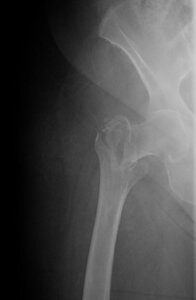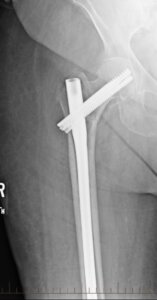Hip Fracture (Broken Hip)
What is a Hip Fracture?
A hip fracture is a break of the top part of the femur or thigh bone. These fractures usually result from high energy injuries such as car accidents in younger patients and most often from falls in the elderly patient. The hip can be broken into many pieces or just crack slightly depending on the quality of bone and the type of injury. These broken hips are described according to where and how the bone breaks. The type of break is important because it determines if surgery is required and what type of operation is needed. Surgeons broadly classify fractures into femoral neck fractures, intertrochanteric femur fractures, greater trochanteric femur fractures and subtrochanteric femur fractures.
What Does the Hip Do?
The upper part of the femur which includes the femoral head, femoral neck and proximal femoral shaft makes up the bottom half of the hip joint. It provides stability and supports the entire body weight for walking, running and jumping. Various muscles that allow patients to flex and extend the hip and bring the leg out to the side attach to these bones.
How is a Hip Fracture Diagnosed?
To diagnose a hip fracture, your doctor will use a physical examination and imaging tests. As expected, almost all patients with a broken hip have hip pain. Sometimes they have knee pain as well. Just because a patient can walk does not mean that they don’t have a broken bone. It is important for doctors to ask patients if they have a history of cancer because some types of cancer can weaken bone and lead to fractures.
X-rays are used to evaluate the location and severity of the broken bone. This helps doctors and patients make an informed decision on treatment. Often 2 or more x-rays are taken to show the injury pattern. If multiple cracks exist, a CT(Computed Tomography) scan is often ordered to help plan treatment and surgery. Sometimes an MRI is ordered for small fractures or to help diagnose stress fractures that do not show up on plain x-rays.

Hip Fracture X-Ray
Hip Fracture Treatment & Surgery
Hip fractures are generally treated with surgery. Depending on the location and stability of the fracture, your doctor will develop a personalized treatment plan according to your age, physical condition and medical history. Physical therapy may be an option if non-surgical treatment is recommended.
Non-Surgical Treatment for Broken Hips
Very few fractured hips in adults are treated without surgery. Isolated greater trochanteric hip fractures can be treated non-surgically.
When patients are extremely ill and have displaced, unstable hip fractures, families often ask if surgery should be done at all. This is an excellent question. Without surgery, most patients with a broken hip develop bed sores, pneumonia, recurrent urinary tract infections and experience continued pain. Even in patients at the end of life, this can be an awful process. As a result, most surgeons recommend operative intervention so that patients can be mobilized and cared for with the least pain possible.
If non-operative care is chosen, regular follow-up care for a physical exam and x-rays is important to ensure that the fracture stays in good position and heals appropriately. Cutting down or quitting smoking and tight blood sugar control if you are a diabetic is important for the healing process. One fall or continued lack of compliance with early walking against medical advice can cause bones to move and result in the need for surgery.
Depending on health and injury pattern this bone can take 3-4 months to heal without surgery. Physical therapy for hip and knee range of motion is started around 6 weeks once bone has healed enough to prevent displacement with motion.
Surgical Treatment for Hip Fractures
Surgeons like to fix fractured hips as soon as possible. Occasionally surgery has to be delayed if patients are too sick or unstable from a medical standpoint for surgery. The type of fracture determines the type of surgery that is required.
Surgery for Femoral Neck Fractures
Hip fractures that occur in the femoral neck may require surgery depending on the location of the break, whether the broken bones are out of place (displaced) and the severity of the fracture.
Nondisplaced femoral neck fractures can be treated with 3 screws placed through small incisions. This surgery takes less than 30 minutes and allows for immediate weight bearing in the elderly patient.
Displaced femoral neck fractures are treated with full or partial hip replacements depending on patient age and function. These surgeries require slightly larger incisions, take 45 to 90 minutes and also allow for immediate weight bearing. The most common treatment is an intramedullary nail placed through a small incision at the hip or knee. This surgery has an extremely high success rate and often allows for immediate weight bearing. Intertrochanteric and subtrochanteric hip fractures can be treated with plates and screws or intramedullary nails. This choice is based on fracture type and surgeon preference. Plates and screws must be placed through larger incisions while nails can usually be done with smaller incisions. Both surgeries take about an hour and patients are allowed immediate weight bearing.
In cases where there is severe injury to the muscles, nerves or arteries or there is significant contamination with dirt, rocks or grass from the injury, some patient require external fixation prior to definitive surgical treatment. This is an operation where metal pins are placed into the bone through small cuts and connected to bars to give some stability to the bone. After secondary operations to clean the wound or recovery of skin injuries, the external fixator can be removed and plates and intramedullary nails or plates and screws can be placed.
It is important to choose your surgeon wisely. Extensive surgical experience can be helpful in achieving a good result and avoiding complications. Collectively, ROC orthopedic surgeons have performed more hip fracture operations than any practice in Northern Nevada and take pride in outstanding surgical results.
After surgery, patients are often allowed to bear weight immediately. Patients will need to use a walker or crutches for the first 6 weeks. Gentle motion of the hip and knee is begun early to prevent stiffness. Gradually this motion is increased and physical therapy is begun around 6 weeks after surgery if the patient has residual knee or ankle stiffness. Your doctor may decide to put you on a blood thinner after surgery for 2-6 weeks depending on your risk factors.

Postoperative X-Ray of Hip Fracture
Hip Fracture Surgery Risks & Complications
Complications can occur with hip fracture surgery. Some of the most common risks and complications include:
Infection is a risk with any surgery, no matter how small. The risk is much bigger for larger and more contaminated traumatic wounds. A dose of antibiotics given prior to surgery helps to make this risk as small as possible.
Injury to blood vessels or nerves can occur following hip fracture surgery. This can be reduced by having an experienced surgeon involved in your care.
Blood clots is a common risk that can develop in the legs and go to the lungs. This can cause serious bleeding problems and even death. Noncompliance with blood thinning medication can have fatal consequences.
Slight difference in leg length can occur if a joint replacement is performed. It is possible that the leg may be slightly longer or shorter. It may also dislocate if postoperative precautions and instructions are not followed.
Recovery Time for Hip Fracture Surgery
Most people with hip fractures do very well and return to prior activities and function. By six weeks, patients are extremely comfortable. Aggressive return to activity too early can result in re-fracture, hardware breakage or nonunion. In these cases, revision surgery is required. Sometimes metal hardware can irritate muscles and tendons. This can be removed one year after surgery.
In need of an orthopedic specialist? Schedule an appointment with one of our specialty-trained Fracture & Trauma doctors to talk through your options. Reno Orthopedic Clinic offers comprehensive treatment for a full range of traumatic injuries at multiple convenient locations in Reno, Sparks and Carson City.
